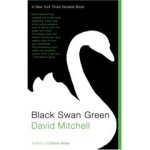To be a character in David Mitchell’s fiction is to be caught in a nexus of powerful forces, only dimly understood by both master and slave. Jacob is entrapped by Chief Deputy Vorstenbosch and interpreter-spy  Hanzaburo. Batavia and Nagasaki fight for control of Dejima. The Dutch East India Trading Company struggles with Japanese bureaucrats and spies, and with Shogunal authority, as well. Both the Dutch trading company and the Shogunate are hoodwinked by the spiritual order of Lord Abbot Enomoto, whose acolytes abduct women, rape and impregnate them, and then harvest their squalling infants at birth for a sacrifice on the altar of an insane belief in immortality. And lastly, France, England, Russia, and Holland fight for access and control of global markets and resources. People, families, communities, and nation-states compete for and establish supremacy, only to suffer unexpected reversals of fortune, or even a reversal of a reversal of fortune: “My temporary reverses are reversed,” ponders Shiroyama. How do we escape the master-slave dialectic? By the usual means. By adopting a broader perspective that transcends narrow egoism. That, and a specific Mitchellian commitment. Namely, a commitment to marks, figures, words, journals, letters, scrolls, manuscripts, articles, books—and other modalities of language, whereby one mind touches and informs another, in a gesture of mutual support and recognition. In Cloud Atlas, Adam Ewing writes a journal for his son’s benefit; Sixsmith authors a report to expose the dangers of the Hydra nuclear reactor; Luisa Rey’s investigative journalism blows the whistle on Seaboard. And in The Thousand Autumns of Jacob de Zoet, Jacob pens his investigation into the corruption of Dutch East India Trading Company; he gives a letter and a dictionary to Aibagawa; and he entrusts his Psalter to Uzaemon, who entrusts the Rules of the Order of Mount Shiranui to Jacob, who then painstakingly translates them to open Shiroyama’s eyes to Enomoto’s foul crimes.
Hanzaburo. Batavia and Nagasaki fight for control of Dejima. The Dutch East India Trading Company struggles with Japanese bureaucrats and spies, and with Shogunal authority, as well. Both the Dutch trading company and the Shogunate are hoodwinked by the spiritual order of Lord Abbot Enomoto, whose acolytes abduct women, rape and impregnate them, and then harvest their squalling infants at birth for a sacrifice on the altar of an insane belief in immortality. And lastly, France, England, Russia, and Holland fight for access and control of global markets and resources. People, families, communities, and nation-states compete for and establish supremacy, only to suffer unexpected reversals of fortune, or even a reversal of a reversal of fortune: “My temporary reverses are reversed,” ponders Shiroyama. How do we escape the master-slave dialectic? By the usual means. By adopting a broader perspective that transcends narrow egoism. That, and a specific Mitchellian commitment. Namely, a commitment to marks, figures, words, journals, letters, scrolls, manuscripts, articles, books—and other modalities of language, whereby one mind touches and informs another, in a gesture of mutual support and recognition. In Cloud Atlas, Adam Ewing writes a journal for his son’s benefit; Sixsmith authors a report to expose the dangers of the Hydra nuclear reactor; Luisa Rey’s investigative journalism blows the whistle on Seaboard. And in The Thousand Autumns of Jacob de Zoet, Jacob pens his investigation into the corruption of Dutch East India Trading Company; he gives a letter and a dictionary to Aibagawa; and he entrusts his Psalter to Uzaemon, who entrusts the Rules of the Order of Mount Shiranui to Jacob, who then painstakingly translates them to open Shiroyama’s eyes to Enomoto’s foul crimes.
David Mitchell’s Master-Slave Dialectic
July 14, 2010Black Swan Green
April 29, 2010In works ranging from ghostwritten to Cloud Atlas, David Mitchell has shown that he’s a fearless and an eminently capable writer. His formal inventiveness and experimentation with styles, points of view, and non-linear plot structures yields a richly conceptual fiction.
 In Black Swan Green, however, Mitchell eschews post-modern pyrotechnics in favor of a simple narrative style. Set in the village of Black Swan Green in Worcestershire, England in the early 1980s, we follow a year in the life of Jason Taylor, 13-year old English chap, who suffers from a stammer he calls Hangman and writes poetry under the nom de plume Eliot Bolivar. Like many adolescents, Jason struggles with mortality, adult hypocrisy, and the pain of being different.
In Black Swan Green, however, Mitchell eschews post-modern pyrotechnics in favor of a simple narrative style. Set in the village of Black Swan Green in Worcestershire, England in the early 1980s, we follow a year in the life of Jason Taylor, 13-year old English chap, who suffers from a stammer he calls Hangman and writes poetry under the nom de plume Eliot Bolivar. Like many adolescents, Jason struggles with mortality, adult hypocrisy, and the pain of being different.
This narrative change of pace is a refreshing departure for Mitchell. You’ll almost look in vain for physical descriptions, for instance, in Cloud Atlas, where, if you are as vigilant as a bird of prey, you might notice that Rufus Sixsmith wears a gabardine coat. Like Saramago, with whom he otherwise has little in common, Mitchell has a tendency to soar off the page into abstract realms. But with Black Swan Green, he plunges headlong into the bright, redolent world of sensory details.
Jason’s sister’s boyfriend, for instance, has … “exploding red hair, sooty freckles, and a bouncy walk. He wore a peach shirt under a baggy indigo sweater, black drainpipes, one of those studded belts that sags loose off your hips, and winkle-pickers with white tube socks…” Luscious mangoes taste like “perfumed peaches, bruised roses” and beef “like deep-sea phlegm,” and the kitchen smells of “lavender and bacon rinds.”
As the vibrant world of Black Swan Green unfolds, we learn that Jason is a verbifyer extraordinaire—”chuntering,” “clackering,” and “snaffling,” as well as “juddering,” “knackering,” and “elasticking”—who, in true Mitchellian fashion, is also profoundly sensitive to the great incongruities of the world:
I dip my fountain pen into a pot of ink, and a Wessex helicopter crashes into a glacier on South Georgia. I line up my protractor on an angle in my Maths book and a Sidewinder missile locks onto a Mirage III. I draw a circle with my compass and a Welsh Guard stands up in a patch of burning gorse and gets a bullet through the eye.
Mitchell’s novel is bursting with cinematographic scenes. Like the time when Jason is injured and finds himself in the foreboding House in the Woods, being tended to by an old, mysterious woman who is haunted by the memory of her dead brother. Or the almost-kiss with tomboy Dawn Madden who has eyes of dark honey and a throat of white chocolate.
But my favorite scene is Jason’s mad dash through neighborhood backyards to gain membership into a secret society called Spooks. He clambers over a fence, sprints through an abandoned yard overgrown with weeds, then an even dodgier lot with two fat ladies watching TV, then Mr. Broadwas’ yard with the sprinklers swsss-swwss-swwwsssing away, then “a concrete meringue” with ornaments, gravel, and gnomes, then a tight-rope walk across a 10-foot high fence hovering over a greenhouse, and finally through a backyard adorned with a trellis of roses and a family playing Twister in their cottage. The scene combines the adventure of childhood with the magic of prose fiction.
After all, storytelling is a virtual romp through distant or neighboring yards.
Clouds, Twisting and Twining (5 of 5)
April 7, 2010
Random stuff from my notebook. Impressions, musings, and scribblings. Finding faces in the sky. Tracing contrails. Cloud seeding. Precipitations.
1. Cloud Atlas is a meterology of spirit. Mitchell fictionalizes the various shapes that the will to power assumes across space and time. He’s like Hegel, who writes a phenomenology of spirit, in this respect except Mitchell’s a good prose stylist. That, and he doesn’t believe history is governed by logic or rules.
4. Save X, then X will save Y, and Y will be someone you love.
5. Human nature is a hydra, as is the HYDRA nuclear reactor, the most pernicious manifestation of the will to power. Unlimited power is a mushroom cloud that destroys indiscriminately.
6. Although he’s a hapless, gullible man (a notary from San Francisco, no less!), Adam Ewing has great philosophical insight. Such insight isn’t linear or cumulative or progressive. It’s episodic. And it’s just as likely to occur in the 1850s as it is in the early 21st century.
7. In Frobisher’s suicide letter, his riff on eternal recurrence is wrong. But that’s okay. His exuberance comes from Nietzsche who partially botches it, too. Eternal recurrence isn’t a sequence of events that happens in the exact same order ad infinitum. It’s a metaphysical reality, namely, the will to power, which is indepedent of time in a way that its phenomenal appearances are not.
8. Adam Ewing isn’t represented as having a birthmark, but I bet you an ARC of The Thousand Autumns of Jacob de Zoet that he does. He reads and writes, he saves Attua, he suffers at the hands of Dr. Goose, he diagnoses the problem of the existence and even proposes a solution, thank you very much, his journal is read by Frobisher, and I know—I just know—that when he gets to San Francisco, his comet-shaped birthmark, which no one knows about, not even David Mitchell, will throb slightly under his shirt when he nears an old haunt of Mark Twain’s.
9. Frobisher reads Ewing’s journal. Luisa reads Frobisher’s letters and listens to his Cloud Atlas Sextet. Cavendish reads “Half Lives.” Sonmi watches a disney about Cavendish’s ghastly ordeal. Zach’ry invokes Sonmi through oral traditions. I read Cloud Atlas. You read this post—and off we go. History is intertextual. Inter-subjective, too. We’re interlocking words, stories, and experiences. Like Mozartian leitmotifs.
10. My love of symmetry demands a ten!
Clouds, Twisting and Twining (4 of 5)
April 6, 2010In “The Letters from Zedelghem,” Robert Frobisher, a charming rogue and musical genius, comments on the bizarre structure of his Cloud Atlas Sextet, asking whether it’s revolutionary or gimmicky. Hapless Pisces that I am, I’ve risen to Mitchell’s deftly angled fly. The structure of Cloud Atlas allows  Mitchell to do two things, or I should say at least two things: one is interesting meh; the other, incredible, astonishing, mind-blowing. Add superlative of choice. By having the chronology of the story end in the middle of the book, Mitchell reinforces the theme of temporal non-linearity or eternal recurrence. The will to power isn’t subject to time. It’s eternally active and is equally present in the 1850s (when Ewing is writing his journal), the 1930s (when Frobisher is composing his Cloud Atlas Sextet), the 1970s (when investigative journalist Luisa Rey is exposing Seaboard), the 2000s (when Cavendish is penning his memoirs), as it is now in 2010, and beyond. Because the will to power is eternally active, it has no beginning, middle, or end. It’s ageless. Which is why, in part, Mitchell cleverly “ends” the narrative in the 1850s, where it “began.” This is a hip, cool post-modern maneuver, to be sure, but it’s hardly revolutionary. Wacky timelines abound. What is revolutionary is constructing a novel with TWO endings: a chronological ending (in the middle) and a narrative ending (at the end) on page 528. By diverging the storyline and timeline in this way, Mitchell creates two lines-of-sight that produce a unique parallax effect. We perceive two things at once, as happens in the morning when your eyes, still goofy from sleep, cross in the shower, magically doubling the label on the shampoo bottle. On the one hand, we see how Mitchell’s fictional story ends—dystopia gives way to societal collapse and a post-apocalyptic future. On the other, we see ourselves at the present moment—we’re readers of a story, a collective story, that has an uncertain future. We don’t know how history will unfold. Which is why we face a profound choice. Enter: Mitchell’s modified version of Pascal’s wager.
Mitchell to do two things, or I should say at least two things: one is interesting meh; the other, incredible, astonishing, mind-blowing. Add superlative of choice. By having the chronology of the story end in the middle of the book, Mitchell reinforces the theme of temporal non-linearity or eternal recurrence. The will to power isn’t subject to time. It’s eternally active and is equally present in the 1850s (when Ewing is writing his journal), the 1930s (when Frobisher is composing his Cloud Atlas Sextet), the 1970s (when investigative journalist Luisa Rey is exposing Seaboard), the 2000s (when Cavendish is penning his memoirs), as it is now in 2010, and beyond. Because the will to power is eternally active, it has no beginning, middle, or end. It’s ageless. Which is why, in part, Mitchell cleverly “ends” the narrative in the 1850s, where it “began.” This is a hip, cool post-modern maneuver, to be sure, but it’s hardly revolutionary. Wacky timelines abound. What is revolutionary is constructing a novel with TWO endings: a chronological ending (in the middle) and a narrative ending (at the end) on page 528. By diverging the storyline and timeline in this way, Mitchell creates two lines-of-sight that produce a unique parallax effect. We perceive two things at once, as happens in the morning when your eyes, still goofy from sleep, cross in the shower, magically doubling the label on the shampoo bottle. On the one hand, we see how Mitchell’s fictional story ends—dystopia gives way to societal collapse and a post-apocalyptic future. On the other, we see ourselves at the present moment—we’re readers of a story, a collective story, that has an uncertain future. We don’t know how history will unfold. Which is why we face a profound choice. Enter: Mitchell’s modified version of Pascal’s wager.
If we believe humanity is a ladder of tribes, a colosseum of confrontation, exploitation & bestiality, such a humanity is brought into being…. If we believe that humanity may transcend tooth & claw, if we believe divers races & creeds can share this world as peacably as the orphans share their candlenut tree, if we believe leaders must be just, violence muzzled, power accountable & the riches of the Earth & its Oceans shared equitably, such a world will come to pass.
The glory of Mitchell’s aesthetic achievement is that he adroitly frames a narrative that “starts” an extra-fictional reality when Cloud Atlas “ends,” namely, a reader who, anxious, worried, and not a little terrified by the state of the world, begins to wonder about the kind of history he wants to help write. How will you manifest your will to power? That’s Mitchell’s genius in Cloud Atlas.
Clouds, Twisting and Twining (3 of 5)
April 5, 2010According to Ted Gioia at The New Canon, the structure of Cloud Atlas is palindromic. “The five opening sections each represent the opening of a tale that will be concluded, in reverse order, by the five final sections of the book.” Schematically, the structure looks like this:
I (.5) – II (.5) – III (.5) – IV (.5) – V (.5) – VI (1) – V (.5) – IV (.5) – III (.5) – II (.5) – I (.5)
Cloud Atlas starts with the first half of “The Pacific Journals of Adam Ewing” circa the 1850s and ends, several hundred pages later, with the last half of his journals, still in the 1850s, for a total of six novellas. “Sloosha’s Crossing,” the narrative centerpiece, represented here by VI, is the only novella that’s not spliced and diced. So while the story starts with Adam and ends with Adam, its temporal arc cuminates in the middle of the novel circa an unknown date in a post-apocalyptic future. Regarding the structure of Cloud Atlas, I agree with Gioia that it’s palindromic, but only superficially so, that is, only at the level of chapter headings. They can be read left to right, or right to left. It doesn’t matter. Their order stays the same. But the story itself isn’t palindromic. It means something read in one direction that it doesn’t mean in the other. A question intrudes, which Mitchell anticipates with a meta-fictional flourish in “The Letters from Zedelghem,” Why this bizarre structure? Is it revolutionary or gimmicky? Like droplets of moisture in a cloud, ideas are swirling, mingling, and crystallizing in my mind, and I’m eager as hell to share them tomorrow. Stay tuned.



 Posted by Kevin Neilson
Posted by Kevin Neilson 